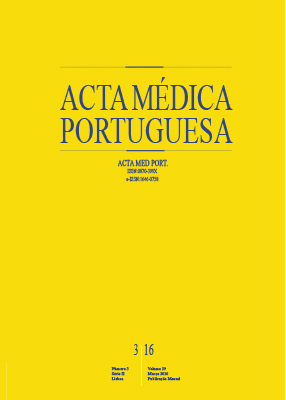Autismo e Marcadores Precoces do Neurodesenvolvimento
DOI:
https://doi.org/10.20344/amp.6790Palavras-chave:
Desenvolvimento da Criança, Perturbação Autística, Perturbações do Desenvolvimento, Prognóstico.Resumo
Introdução: A perturbação do espectro do autismo, neste texto também designada por autismo, é uma patologia crónica do neurodesenvolvimento, que se manifesta precocemente na infância por alterações da interação social, comunicação e comportamento repetitivo. Não estando disponíveis biomarcadores específicos, o diagnóstico baseia-se exclusivamente na avaliação clínica. O objetivo deste estudo é verificar quais os marcadores precoces do desenvolvimento psicomotor ou neurodesenvolvimento, que se correlacionam significativamente com a gravidade da clínica central do autismo, quocientes de desenvolvimento e com a função adaptativa.
Material e Métodos: Procedemos ao estudo retrospetivo de uma população de 1 572 indivíduos com o diagnóstico de autismo seguidos na Unidade de Neurodesenvolvimento e Autismo do Centro de Desenvolvimento da Criança do Hospital Pediátrico do Centro Hospitalar e Universitário de Coimbra. Analisámos seis marcadores precoces do desenvolvimento psicomotor: idades de aquisição ‘da marcha’, ‘das primeiras palavras’, ‘das primeiras frases’, ‘do controlo de esfíncter vesical diurno’, ‘do controlo de esfíncter vesical noturno’ e de início das primeiras queixas. Posteriormente dividimos a amostra em três subgrupos de gravidade clínica segundo a escala Childhood Autism Rating Scale e pesquisamos diferenças significativas entre os três subgrupos relativamente aos seis marcadores definidos.
Resultados: O marcador ‘idade de aquisição das primeiras frases’ foi, de entre os seis, aquele que se correlacionou mais fortemente com as variáveis da clínica de autismo, quocientes de desenvolvimento/inteligência e comportamento ou função adaptativa. Na divisão da amostra em subgrupos de gravidade clínica, foi o de maior gravidade que mostrou idades de aquisição dos marcadores do neurodesenvolvimento mais tardias e idades mais precoces de manifestação das primeiras queixas.
Discussão: Este estudo vem demonstrar a utilidade clinica dos marcadores precoces do desenvolvimento psicomotor nos primeiros anos de vida, como preditores da gravidade da clinica de autismo, cognição e função adaptativa duma vasta população com autismo. Deste modo, estes dados vêm contribuir, em associação com outros, para o prognóstico e previsão da história natural do autismo.
Conclusão: Tendo em conta os resultados deste estudo, recomenda-se fortemente o registo da ´idade de aquisição das primeiras frases´ a todos os clínicos que tenham contacto com crianças com autismo.
Downloads
Downloads
Publicado
Como Citar
Edição
Secção
Licença
Todos os artigos publicados na AMP são de acesso aberto e cumprem os requisitos das agências de financiamento ou instituições académicas. Relativamente à utilização por terceiros a AMP rege-se pelos termos da licença Creative Commons ‘Atribuição – Uso Não-Comercial – (CC-BY-NC)’.
É da responsabilidade do autor obter permissão para reproduzir figuras, tabelas, etc., de outras publicações. Após a aceitação de um artigo, os autores serão convidados a preencher uma “Declaração de Responsabilidade Autoral e Partilha de Direitos de Autor “(http://www.actamedicaportuguesa.com/info/AMP-NormasPublicacao.pdf) e a “Declaração de Potenciais Conflitos de Interesse” (http://www.icmje.org/conflicts-of-interest) do ICMJE. Será enviado um e-mail ao autor correspondente, confirmando a receção do manuscrito.
Após a publicação, os autores ficam autorizados a disponibilizar os seus artigos em repositórios das suas instituições de origem, desde que mencionem sempre onde foram publicados e de acordo com a licença Creative Commons









